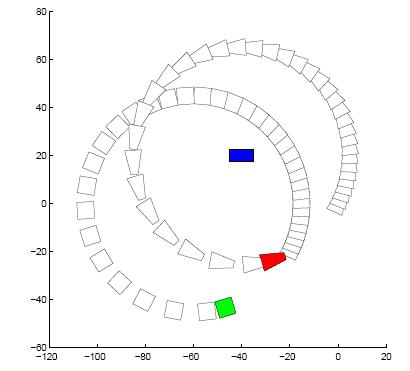Formation State Estimation and Control: Difference between revisions
Jump to navigation
Jump to search
| Line 10: | Line 10: | ||
=== References === | === References === | ||
* [http://ieeexplore.ieee.org/stamp/stamp.jsp?arnumber=01435482 P. Tabuada, G. J. Pappas, P. U. Lima, "Motion Feasibility of Multi-Agent Formations", IEEE Transactions on Robotics, Vol. 21 (3), pp. 387-392, 2005 ] | * [http://ieeexplore.ieee.org/stamp/stamp.jsp?arnumber=01435482 P. Tabuada, G. J. Pappas, P. U. Lima, "Motion Feasibility of Multi-Agent Formations", IEEE Transactions on Robotics, Vol. 21 (3), pp. 387-392, 2005 ] | ||
* | * [http://ieeexplore.ieee.org/stamp/stamp.jsp?arnumber=945513&isnumber=20467 P. Tabuada, G. J. Pappas, P. U. Lima, "Feasible Formations of Multi-Agent Systems", Proc. ACC2001 - American Control Conference, Arlington, VA, USA, 2001 ] - finalist of Best Student Paper Award | ||
* Paulo Tabuada's PhD thesis | * [http://welcome.isr.ist.utl.pt/img/pdfs/559_tese1x.pdf Paulo Tabuada's PhD thesis] | ||
Revision as of 17:45, 14 November 2008
Multi-robot formation feasibility, formation control and formation state estimation have been subject of research at the ISLab since 200.
Formation Feasibility
We developed a systematic framework for studying formation motion feasibility of multiagent systems. Algebraic conditions that guarantee formation feasibility (i.e., that the specified geometric constraints can be staisfied) given the individual robot kinematics were determined. Our framework also enables us to obtain lower dimensional control systems describing the group kinematics while maintaining all formation constraints.
References
- P. Tabuada, G. J. Pappas, P. U. Lima, "Motion Feasibility of Multi-Agent Formations", IEEE Transactions on Robotics, Vol. 21 (3), pp. 387-392, 2005
- P. Tabuada, G. J. Pappas, P. U. Lima, "Feasible Formations of Multi-Agent Systems", Proc. ACC2001 - American Control Conference, Arlington, VA, USA, 2001 - finalist of Best Student Paper Award
- Paulo Tabuada's PhD thesis
